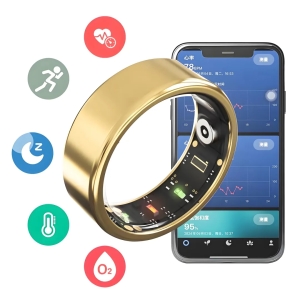

This wearable product, the smart health ring, is equipped with functions such as blood pressure, blood oxygen, heart rate, sleep monitoring, and body temperature monitoring. It falls into the category of medical devices and requires registration approval from the National Medical Products Administration (NMPA) to be marketed in China.

Below is an overview of the NMPA registration process for such smart rings:
I. Product Classification and Definition
Determine Medical Device Classification:
According to the Classification Directory of Medical Devices, smart rings with monitoring functions such as blood pressure, blood oxygen, and heart rate are typically classified as Class II medical devices (specific classification requires further confirmation based on product functions and risk levels). If the product involves diagnostic functions or high-risk monitoring functions, it may be classified as Class III medical devices.Product Naming and Description:
Clearly define the product's name, model, functional description, scope of application, etc., as required by the NMPA.
II. Prepare Technical Documents
Product Technical Files:
Product Technical Requirements: Including performance indicators, testing methods, safety standards, etc.
Product Manual: Detailedly describe product functions, usage methods, contraindications, precautions, etc.
Design Drawings and Principle Descriptions: Including hardware design, software algorithms (such as blood pressure and blood oxygen monitoring algorithms), etc.
Manufacturing Process: Production processes, key process parameters, etc.
Risk Management Documents:
Risk Assessment Report: Identify potential risks of the product (such as measurement errors, data security, etc.) and propose control measures.
Risk Control Measures: Ensure the safety of the product under normal use conditions.
Software Research Materials (if applicable):
If the product contains software (such as data analysis, monitoring algorithms, etc.), submit software description documents, including software architecture, algorithm principles, network security measures, etc.
III. Quality Management System
Establish a Quality Management System:
Establish a quality management system according to the Good Manufacturing Practice (GMP) for Medical Devices and obtain ISO 13485 certification. Ensure that design and development, production, inspection, sales, and other processes comply with NMPA requirements.System Verification:
The NMPA may conduct on-site inspections of the production site to confirm the effectiveness of the quality management system.
IV. Product Testing
Type Testing:
Electrical safety (e.g., GB 9706.1)
Electromagnetic compatibility (EMC)
Performance testing (e.g., accuracy of blood pressure, blood oxygen, and heart rate measurements)
Environmental adaptability (e.g., temperature, humidity, vibration, etc.)
Send the product to an NMPA-approved testing institution for testing. Testing items include but are not limited to:
Obtain a qualified test report.
Testing Standards:
Region | Item | Standards |
Domestic/Europe | Safety Regulations | GB 9706.1-2020/IEC 60601-1:2005/AMD2:2020 YY 9706.111-2021/IEC 60601-1-11:2015/AMD1:2020 GB/T 14710-2009 YY9706.108-2021 (if applicable) IEC 60601-1-8:2006/AMD2:2020 |
EMC | YY 9706.102-2021/IEC 60601-1-2:2014/AMD1:2020 | |
Performance (Special Standards) | Body Temperature: YY 9706.256-2023 EN ISO 80601-2-56:2017/AMD1:2018 Blood Pressure: YY9706.230-2023/IEC 80601-2-30:2018 ECG: YY 9706.247-2021/IEC60601-2-47:2012/EN60601-2-47:2015 Blood Oxygen: YY 9706.261-2023/ISO 80601-2-61:2017/EN ISO 80601-1-61:2019 | |
Biocompatibility | GB/T 16886.5-2017 EN ISO 10993-5:2009 GB/T 16886.10-2017 EN ISO 10993-10:2023 GB/T 16886.11-2017 EN ISO 10993-11:2017 EN ISO 10993-23:2021 | |
Cleaning,Disinfection,and Sterilization | WS 310.3-2016 WS/T367-2012, YY/T 0734.1-2018, YY/T 0734.5-2020 AAMI TIR12-2020 AAMI ST98-2022 ISO 15883-5:2021, ISO15883-6:2011 |
Clinical Evaluation:
For blood pressure, blood oxygen, body temperature modules, atrial fibrillation, respiratory rate, etc., clinical accuracy verification is required to demonstrate the product's safety, effectiveness, and accuracy.
V. Prepare Registration Application Materials
Registration Application Form:
Fill out the NMPA Medical Device Registration Application Form, clearly stating product information, applicant information, etc.
Technical Documents:
Including product technical requirements, manuals, risk management documents, software research materials, etc.
Quality Management System Documents:
Provide relevant certificate documents of the quality management system.
Test Reports:
Submit type test reports.
Clinical Evaluation Materials:
Submit clinical evaluation reports or clinical trial reports (if applicable).
VI. Submit Registration Application
Online Submission:
Submit registration application materials through the NMPA Medical Device Electronic Reporting System.
Fee Payment:
Pay the registration fee according to NMPA regulations.
VII. Technical Evaluation
NMPA Evaluation:
The NMPA conducts a technical evaluation of the submitted materials and may request supplementary materials or conduct on-site inspections.
Supplementary Materials:
Submit supplementary materials promptly based on evaluation opinions.
VIII. Approval Decision
Approval Granted:
If the evaluation is passed, the NMPA will issue a Medical Device Registration Certificate.
Approval Denied:
If the evaluation is not passed, modifications based on feedback opinions are required before resubmission.
IX. Obtain Registration Certificate
Certificate Issuance:
The product can be legally sold and used in the Chinese market after obtaining the Medical Device Registration Certificate issued by the NMPA.
Certificate Validity:
The Medical Device Registration Certificate is typically valid for 5 years and requires renewal before expiration.
X. Post-market Regulation
Adverse Event Monitoring:
Establish an adverse event monitoring system to promptly report and handle product-related adverse events.
Regular Updates:
Regularly update registration information or submit periodic risk evaluation reports as required by the NMPA.
Quality System Maintenance:
Continuously maintain and improve the quality management system to ensure product compliance with regulatory requirements.
Notes
Regulatory Updates:
Stay closely attentive to the latest policies as NMPA regulations and requirements may be updated.
Professional Support:
It is recommended to collaborate with professional medical device registration agencies or legal consultants to ensure a smooth registration process.
Time and Cost:
The registration process typically takes 8-12 months, with the specific duration depending on product complexity and evaluation progress.
By following this process, the smart health ring can legally enter the Chinese market and be sold.
HOM Medical Association plans the entire registration path based on the actual situation of the enterprise, collaborates as a team, prepares registration materials, builds the system, conducts registration testing simultaneously, organizes clinical materials, and contacts research units. Upon completion of the test report, clinical accuracy verification can be initiated, with simultaneous submission
鸿盟医学
医疗器械全球注册咨询、医疗器械临床试验、医疗器械质量管理体系(ISO13485/GMP/QSR)、医疗器械可用性研究、
医疗器械法规培训众多的专业技术服务咨询机构
微信号:hom_medical、18018710006 联系电话:18018716006
 鸿盟标准技术(深圳有限公司)
鸿盟标准技术(深圳有限公司)




